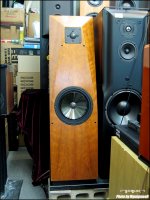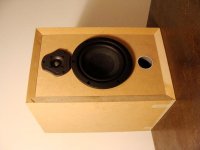I wonder about the Avalon Eclipse loudspeaker and and their arrangement of transducers.
Until this day I don't understand, which benefit there is.
The presently very small acoustical opening angle in the crossover aera is for me clearly a disadvantage.
A coaxial allocation brings the highest value degrees of opening angle (unfortunately a delay time compensation actually is necessary).
Thus the bass driver and the high frequency driver must be mounted as close as possible in case of not present coaxial transducers like Beyma's 8CX300NdE about
http://profesional.beyma.com/pdf/8CX300NdE.pdf
Therefore I observe by several manufacturers, that the circular recesses on the carrier plate of their dome tweeters is provided for even tighter mounting to get highest possible opening angle values.
An example you will find about
http://forum.edesignaudio.com/picture.php?albumid=196&pictureid=2607
What I don't take into account in my considerations on this Avalon model ? - go to
Avalon Eclipse loudspeaker | Stereophile.com
You can see the conflicting considerations beautiful in the attached jpg files.
Until this day I don't understand, which benefit there is.
The presently very small acoustical opening angle in the crossover aera is for me clearly a disadvantage.
A coaxial allocation brings the highest value degrees of opening angle (unfortunately a delay time compensation actually is necessary).
Thus the bass driver and the high frequency driver must be mounted as close as possible in case of not present coaxial transducers like Beyma's 8CX300NdE about
http://profesional.beyma.com/pdf/8CX300NdE.pdf
Therefore I observe by several manufacturers, that the circular recesses on the carrier plate of their dome tweeters is provided for even tighter mounting to get highest possible opening angle values.
An example you will find about
http://forum.edesignaudio.com/picture.php?albumid=196&pictureid=2607
What I don't take into account in my considerations on this Avalon model ? - go to
Avalon Eclipse loudspeaker | Stereophile.com
You can see the conflicting considerations beautiful in the attached jpg files.
Attachments
Last edited:
There isn't any.Until this day I don't understand, which benefit there is
I remember that it was mentioned several advantages of Avalon in this case (such as delay compensation between midrange and high frequency).There isn't any.
But these advantages would only be available, if this loudspeaker was not used as near field monitor.
Unfortunately I don't recall, where I have read this.
Last edited:
Maybe the most exactly reasons for that approach I must actually get from the developer. Who know the member-name of Charles Hansen?There isn't any.
http://www.stereophile.com/floorloudspeakers/703/index.html
http://www.audioasylum.com/cgi/vt.mpl?f=speakers&m=251218
http://www.htforum.nl/yabbse/index.php?topic=61926.0
Last edited:
I don't know him !
But looking at the suspected speaker ( and there are many : A Boston cabinet from the eighties ) , since it's a floor stander , the tweeter has to be at hear height , same for the bookshelf , which could be better named ' free stander' .
Also reflection from the cabinet itself has been taken into the design : as the sound propagates to and from the baffle ; diffraction has also been avoided by Avalon using slantwise corners .
But looking at the suspected speaker ( and there are many : A Boston cabinet from the eighties ) , since it's a floor stander , the tweeter has to be at hear height , same for the bookshelf , which could be better named ' free stander' .
Also reflection from the cabinet itself has been taken into the design : as the sound propagates to and from the baffle ; diffraction has also been avoided by Avalon using slantwise corners .
In a 3 or 4 way design it might make sense.
In a 2 way I think the drawbacks outweigh whatever benefits there may be.
In a 2 way I think the drawbacks outweigh whatever benefits there may be.
Maybe the most exactly reasons for that approach I must actually get from the developer. Who know the member-name of Charles Hansen?
Avalon Eclipse loudspeaker | Stereophile.com
Speaker Asylum
http://www.htforum.nl/yabbse/index.php?topic=61926.0
The same name has Ayre's Research Director:
Dr. Davies
Is it the same person?
Isn't it something to do with floor bounce frequency? As said though, it has too many drawbacks in a 2-way with conventional tweeter.
Some thoughts:
The measurements in the Stereophile article show a crossover-frequency of 1 Khz.
Compared to a more conventional crossover-frequency of 2Khz or higher,
the requirement for both drivers being close together is greatly relaxed.
The arrangement in the Avalon gives optimal working-conditions for the tweeter.
Large beveled edges for minimizing diffraction-issues, and a perfectly flat baffle,
without the irregularities that are being caused by a (moving)
irregularly shaped woofer-cone+surround in close proximity of the tweeter.
The measurements in the Stereophile article show a crossover-frequency of 1 Khz.
Compared to a more conventional crossover-frequency of 2Khz or higher,
the requirement for both drivers being close together is greatly relaxed.
The arrangement in the Avalon gives optimal working-conditions for the tweeter.
Large beveled edges for minimizing diffraction-issues, and a perfectly flat baffle,
without the irregularities that are being caused by a (moving)
irregularly shaped woofer-cone+surround in close proximity of the tweeter.
Some thoughts:
The measurements in the Stereophile article show a crossover-frequency of 1 Khz.
Compared to a more conventional crossover-frequency of 2Khz or higher,
the requirement for both drivers being close together is greatly relaxed.
The arrangement in the Avalon gives optimal working-conditions for the tweeter.
Large beveled edges for minimizing diffraction-issues, and a perfectly flat baffle,
without the irregularities that are being caused by a (moving)
irregularly shaped woofer-cone+surround in close proximity of the tweeter.
The requirement may be relaxed by a factor 2, but the drivers are still multiple wavelengths apart. Even in most speakers with closely spaced drivers there is quite some lobing due to a high crossover frequency. Vertical polar response would show quite some lobing in this case too, even worse than in most speakers.
It could have benefits if it was a three way with a woofer close to the floor to deal with the comb filtering from the floor reflection, but in this configuration I see no benefits.
Hello,
I made two 2-way speakers using floor-loaded mid-woofer with the tweeter at ears height; I made steep slopes x-over, Fx near 1.5kHz in order to minimize combs issues. Frankly, as long as listening distance stays more than 2.5M, the vertical comb effect, even if slightly audible, isn't annoying; sure, this type of issue also depends of the inherent directivity of the used mid-woofer.
In the case of the Avalon speaker, I wonder if this design wasn't simply imposed by the marketing department for visual considerations...😀
I made two 2-way speakers using floor-loaded mid-woofer with the tweeter at ears height; I made steep slopes x-over, Fx near 1.5kHz in order to minimize combs issues. Frankly, as long as listening distance stays more than 2.5M, the vertical comb effect, even if slightly audible, isn't annoying; sure, this type of issue also depends of the inherent directivity of the used mid-woofer.
In the case of the Avalon speaker, I wonder if this design wasn't simply imposed by the marketing department for visual considerations...😀
.........
A coaxial allocation brings the highest value degrees of opening angle (unfortunately a delay time compensation actually is necessary).
............
I still have a JBL coaxial (LE14C) from the sixties in perfect working order. The VCs of the mid-twoofer and tweter are perfectly aligned, so there is no time lag. And in those years the coaxial Tannoy drivers carried the VC of the tweeter far behind the Mid-twoofer cone, forming a compression horn between the two.
Guess which of these two conductors was most recognized in the world for their sound? Troels made measurements of the Tannoy and found them to be deficient, however, he noted quite a bit that the Tannoy's wide sound field more than made up for any other deficiencies.
So it's not all measurements, once again.
TannoyMG15
LE14C's
1) Drivers don't have to be aligned to be in phase
2) Aligning drivers doesn't guarantee that they will be in-phase
2) Aligning drivers doesn't guarantee that they will be in-phase
I think both the OP and I are talking about the time delay caused by the misalignment of the different drivers, not phase.
- Home
- Loudspeakers
- Multi-Way
- Large distance between Tweeter and Bass-Midrange like Avalon Eclipse-which advantages

